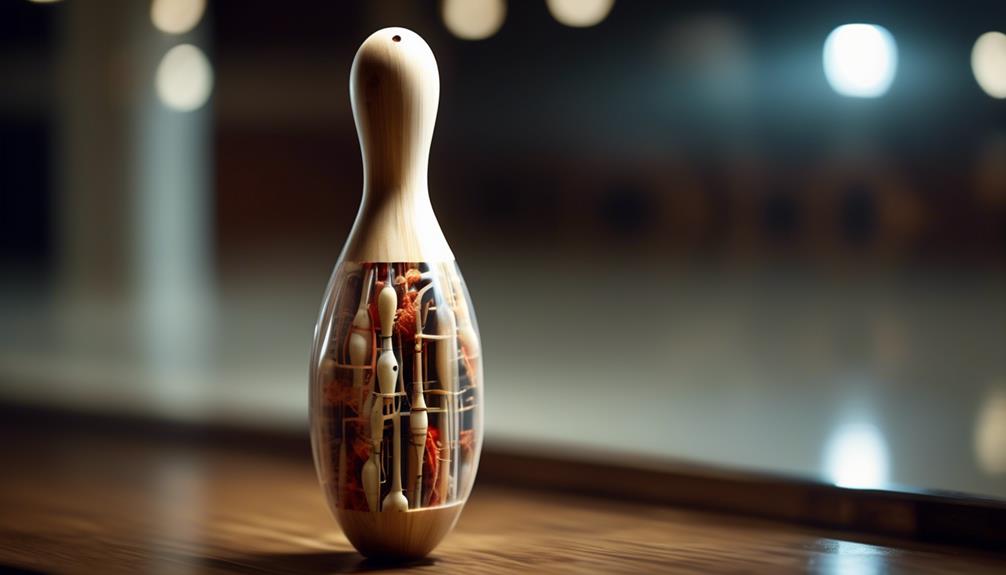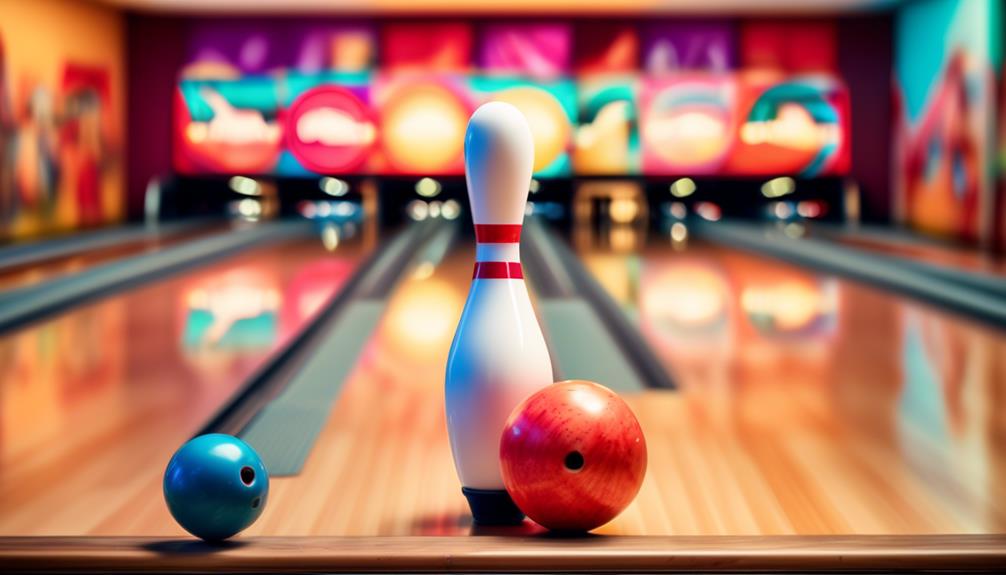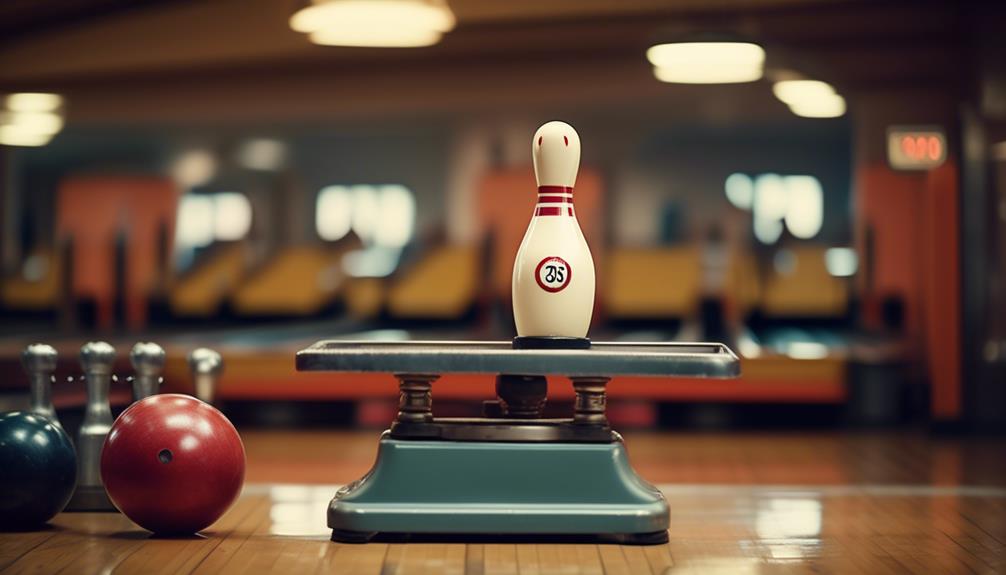The weight of a bowling pin, an often overlooked aspect of one of the world's most popular sports, is, in fact, a critical factor in the overall game dynamics. Governed by strict regulations, the specifications of these pins – including their weight – are meticulously controlled to ensure consistency and fairness in the sport of bowling. Yet, what is the exact weight of a bowling pin? Does it vary from country to country, or is there a universal standard? Furthermore, how does the weight of a pin influence its performance and interaction with the bowling ball? These intriguing questions warrant further exploration.
Key Takeaways
- Bowling pins are made from hard maple wood and weigh between 3 lbs 6 oz and 3 lbs 10 oz.
- Pin weight is important for maintaining fairness and consistency in the game.
- Pin weight affects gameplay, with heavier pins providing a more stable playing environment and lighter pins promoting innovation and strategic thinking.
- Understanding the interplay between pin weight and performance is crucial for strategic adjustments and maintaining the integrity of the game.
The History of Bowling Pins

Tracing back centuries, the evolution of the bowling pin has undergone significant transformations, each change reflecting advancements in technology and alterations in the rules of the game. Rooted in the Bowling etymology, the pin's development is a testament to the adaptive spirit of this enduring sport.
The bowling pin's early design was a simple, wooden cylinder. However, the pin's form has been subject to numerous modifications over time. These changes in Pin evolution were primarily driven by the need for standardization and improved durability. The shift from wood to durable plastic-coated maple was a significant step towards meeting these requirements.
In the mid-19th century, the American Bowling Congress standardized the specifications for bowling pins, including their weight, size, and shape. This was a pivotal moment in Pin evolution, providing a uniform structure for the game across different regions.
With the advent of automatic pin-setting machines in the 1950s, the design of the bowling pin was further refined to ensure compatibility with the new technology. The contemporary bowling pin is now a marvel of engineering precision, meticulously crafted to withstand thousands of high-impact collisions.
In exploring Bowling etymology, one discovers the sport's continual embrace of innovation. From the bowling pin's humble beginnings to its current high-tech incarnation, its transformation is a reflection of the game's dynamic nature. As we continue to advance, it is exciting to ponder what the future holds for the evolution of the bowling pin, a symbol of a game that consistently adapts and thrives.
Bowling Pin Design Specifications
Diving into the specifics of bowling pin design, it becomes evident that each aspect, from its weight and height to its shape and construction material, adheres to strict standards set by the regulating bodies of the sport. Pin aesthetics and design evolution have played a significant role in shaping these standards, ensuring that the pins not only function well but also have a pleasing appearance.
| Specification | Standard | Purpose |
|---|---|---|
| Weight | 3 lbs 6 oz – 3 lbs 10 oz | Ensures consistent pin action |
| Height | 15 inches | Optimizes the challenge of the game |
| Material | Hard maple wood | Provides durability and unique sound |
The design evolution of bowling pins has been driven by the need for consistent gameplay and durability. Initially, pins were made from a variety of materials, including wood, rubber, and plastic. However, hard maple wood emerged as the preferred material due to its strength, weight, and the distinctive sound it produces when hit by a bowling ball.
In terms of pin aesthetics, the traditional white color with red neck markings has remained unchanged for decades. This color scheme offers a stark contrast against the wooden or synthetic lanes, enhancing visibility for players. Additionally, the cylindrical shape tapering to a rounded point is not only visually appealing but also crucial for the pin's balance and movement.
Material Composition of Bowling Pins

Delving into the material composition of bowling pins, it becomes clear that the choice of hard maple wood is pivotal in maintaining the pin's durability, weight, and distinctive sound. The hard maple, a species native to North America, is renowned for its solidity and resilience, perfect for withstanding the repetitive impact experienced in a typical bowling game.
Besides durability, the selection of hard maple wood also contributes to the weight and sound of a bowling pin. The density of this particular wood type results in a bowling pin that adheres to the regulated weight constraints, typically between 3.5 to 3.7 pounds. Additionally, the unique resonating properties of hard maple produce the satisfying "clatter" that bowlers associate with a successful strike.
In keeping with the growing trend towards sustainable materials, the bowling industry also considers pin recycling a significant aspect of the manufacturing process. Once a bowling pin has reached the end of its life cycle, it can be ground down and repurposed into other products, such as particleboard or mulch. This process not only reduces waste but also contributes to a circular economy model, where resources are kept in use for as long as possible.
Moreover, the industry is continually exploring new materials to enhance the performance and lifespan of bowling pins. The future may see the integration of high-tech materials or innovative manufacturing techniques that can provide the same weight and sound characteristics while improving the pin's sustainability profile. This ongoing commitment to innovation ensures that the bowling industry remains at the forefront of modern sporting equipment design.
Understanding Bowling Pin Weight Regulations
Grasping the regulations around bowling pin weight is crucial for both manufacturers and players. We will first explore the official pin weight standards set by governing bodies. Next, we will consider the various factors that can affect a pin's weight and finally, discuss the significance of adhering to these regulations.
Official Pin Weight Standards
In the realm of professional bowling, understanding the weight regulations of bowling pins is paramount, with the official rules stipulating that each pin should ideally weigh between 3 pounds 6 ounces and 3 pounds 10 ounces. This requirement is fundamental to maintain fairness and uniformity in the game.
To further clarify, the following key points should be noted:
- Weight variations are allowed within a small range, ensuring no individual pin has an unfair advantage.
- Pin measurements, including weight, are strictly monitored by bowling associations.
- Pins falling outside of the weight range may impact the game's outcomes and are deemed non-regulation.
- Innovation in pin design and materials must still adhere to these weight standards, preserving the game's integrity while allowing for technological advancement.
Factors Affecting Pin Weight
While understanding the official weight standards is fundamental, it is equally crucial to consider the factors that may affect the weight of bowling pins. Among these factors, pin balancing and weight distribution are key. Pin balancing refers to the strategic placement of weight within the pin to ensure it stands upright, offering a fair challenge to bowlers. Weight distribution, on the other hand, is about evenly spreading the weight across the pin to prevent any unexpected movements upon impact. Both factors are governed by stringent regulations to maintain consistency and fairness in the sport. Innovations are continually explored to perfect these aspects, ultimately enhancing the bowling experience for all players.
Importance of Regulation Compliance
Consistently adhering to the weight regulations set for bowling pins is instrumental in preserving the integrity and fairness of the game. Regulatory compliance ensures a uniform playing field, offering several regulation benefits:
- Consistency: Regulation compliance means that all pins weigh the same, ensuring consistency in gameplay.
- Fairness: Ensuring that all pins adhere to the weight regulations promotes fairness across all players.
- Professionalism: Compliance with weight regulations is a mark of professionalism in the sport of bowling.
- Innovation: Rigorous compliance fosters innovation as manufacturers strive to meet regulations while enhancing pin design.
However, compliance challenges may arise due to manufacturing variances and the need for frequent checks to maintain standards. Nevertheless, understanding the importance of these regulations is key to appreciating the game's nuances.
How Weight Affects Bowling Pin Performance
The weight of a bowling pin significantly influences its performance, particularly with regards to its knockdown and durability. To understand this, it's essential to first comprehend the standards set for bowling pin weight. This will provide a basis for exploring how variances in weight impact a pin's reaction to the bowling ball and its overall lifespan.
Bowling Pin Weight Standards
In understanding the dynamics of bowling, it is crucial to consider the standard weight of bowling pins and how this factor influences their performance. The aesthetics of the pin and bowling terminologies are deeply interconnected with the weight standards. Here are four key points:
- A standard bowling pin weighs approximately 3.6 to 3.7 pounds, providing the optimal balance for consistent performance.
- The weight and shape of the pin influence its movement and reaction when hit by the ball, crucial for the game's outcome.
- Heavier pins tend to be more stable, offering a challenging playing environment.
- Lighter pins can make the game more unpredictable, promoting innovation and strategic thinking.
Understanding these weight standards provides insights into the complex interplay between pin weight and bowling dynamics.
Impact on Pin Knockdown
Building on the knowledge of pin weight standards, it's pivotal to explore how this weight directly impacts the knockdown of pins during a bowling game. The weight of a bowling pin significantly influences Pin Physics and, consequently, the Strike Probability. A heavier pin requires more force to topple, thus making strikes less likely if the bowler's throw lacks adequate power. Conversely, a lighter pin may easily topple but may not trigger the desired chain reaction for a strike. Therefore, understanding the interplay between pin weight and its performance can lead to strategic adjustments, enhancing the bowling experience and fostering innovation in the game. Balancing these factors is key in achieving an optimal strike probability while maintaining the integrity and challenge of the game.
Weight and Pin Durability
Shifting our focus to durability, it becomes evident that the weight of a bowling pin substantially affects its performance and lifespan in the game. Weight distribution plays a significant role in four key areas:
- Stability: A heavier base ensures the pin stands upright, facilitating a fair game.
- Pin Action: The kinetic energy transfer from the bowling ball to the pin is determined by the pin's weight.
- Aesthetics: The pin aesthetics are enhanced by maintaining an optimal weight that doesn't distort its shape over time.
- Longevity: A well-balanced pin, neither too heavy nor too light, can withstand repeated impacts, increasing its useful life.
Incorporating innovation in bowling pin design, focusing on weight considerations, can dramatically enhance the bowling experience while ensuring durability.
The Manufacturing Process of Bowling Pins
Crafting a standard bowling pin involves a meticulous and complex process that ensures both durability and the appropriate weight. The initial stage of this process, often referred to as Pin Shaping, involves the transformation of hard maple or synthetic material into the recognizable form of a bowling pin. This process is carried out with the aid of advanced machinery, guaranteeing precision and consistency.
Once the shape has been established, the pin undergoes a rigorous sanding process to remove any surface imperfections and to prepare it for the painting process. This step is crucial as it ensures the smooth and flawless appearance of the final product.
The next step in the manufacturing process is Pin Painting. This stage involves coating the pin with a layer of white paint, followed by the application of a clear gloss for a shiny finish. Pins are then adorned with the appropriate branding and regulatory markings, ensuring they meet the standards for official use in professional and amateur bowling competitions.
The final step in the manufacturing process is the addition of a protective coat. This coating, typically made from a type of plastic or resin, is applied to enhance the pin's durability and resistance to damage. The application of this coat also provides the pin with its distinctive sound when struck by a bowling ball.
The creation of a bowling pin is a testament to the fusion of craftsmanship and innovation, ensuring a consistent, high-quality product that meets the exacting standards of the sport. The process is a balance of art and science, combining traditional methods with modern technology to produce an integral component of a beloved pastime.
Fun Facts About Bowling Pins

Delving into the fascinating world of bowling pins, there are numerous intriguing facts that highlight their unique characteristics and critical role in the sport of bowling. Bowling pins are far more than simple targets; they are intricate objects of design and engineering that contribute significantly to the game's challenge and excitement.
- Pin Artwork: Bowling pins are typically white, but they often feature unique artwork or branding. This artwork isn't just for aesthetics; it helps players identify their target and adds a personal touch to each game. In professional tournaments, the artwork often includes the event's logo or sponsor, making each pin a piece of memorabilia.
- Bowling Lingo: The sport of bowling has a rich vocabulary filled with unique terms. For example, a 'turkey' is three strikes in a row, while leaving the 5-7, 5-10, or 5-7-10 pins standing is known as the 'lily'. These terms add an extra layer of enjoyment and camaraderie to the game.
- Pin Specifications: Bowling pins must meet specific regulations for weight and size. The standard pin weighs between 3.5 and 3.7 pounds and stands 15 inches tall. These exact dimensions ensure a consistent challenge and fair competition in every game.
- Pin Lifespan: The lifespan of a bowling pin is surprisingly short. A pin typically lasts for about 5,000 games before it starts showing signs of wear and tear. However, many bowling alleys recycle worn-out pins, giving them a new lease of life as novelty items or craft materials.
Frequently Asked Questions
What Is the Cost of a Standard Bowling Pin?"
The cost of a standard bowling pin is influenced by factors such as the materials used in its construction and the complexity of the manufacturing process. Typically, a pin is crafted from hard maple wood and coated with a synthetic material for durability. Prices can range from $10 to $20 per pin, depending on these factors. Innovations in material science and production techniques may have potential for cost efficiency in the future.
How Long Does a Bowling Pin Typically Last Before It Needs to Be Replaced?"
The longevity of a bowling pin is influenced by various Pin Durability Factors such as frequency of use, care, and the quality of the pin itself. Typically, a well-maintained pin can last 7-10 years. Replacement Indicators include visible wear and tear, such as dents or chips, and inconsistent game play. Continual innovation in pin construction and maintenance can further enhance pin longevity, offering cost efficiencies for bowling alleys.
Are There Any Specific Handling or Maintenance Tips for Bowling Pins?"
Bowling pins require regular cleaning to maintain their performance. Use detergent and a soft cloth to prevent damage to the pin's surface. Additionally, proper storage is essential to prolong their lifespan. Keep pins in a dry, temperate location to avoid exposure to moisture or extreme temperatures, which can warp the wood. Regular inspection for cracks or chips will also ensure they remain in good condition for play.
Can You Use Bowling Pins for Other Sports or Activities?"
Certainly, bowling pins can be repurposed for various activities. They can be incorporated into pin artistry, creating unique, innovative designs for aesthetic purposes. Bowling pins are also popular for pin collections, often painted or decorated to reflect personal styles or themes. While not traditionally used in other sports, they can serve as markers or targets in certain activities. However, it's essential to ensure safety when using them outside of their standard bowling context.
What Is the Environmental Impact of Producing Bowling Pins?"
The environmental impact of bowling pin production varies based on material usage and recycling processes. Traditional hardwood pins have a significant footprint due to deforestation and energy-intensive manufacturing. However, material alternatives like recycled plastic or biodegradable substances can reduce ecological harm. Further, implementing robust recycling processes can ensure less waste. This is a key area for innovation, balancing the sport's tradition with sustainable manufacturing practices.
Conclusion
In conclusion, the weight of a bowling pin, regulated at approximately 3.6 to 3.7 lbs, is crucial to the game's dynamics. The pin's weight, coupled with its construction and design, ensures optimal performance and challenge. Understanding the intricacies of bowling pins, from their history to their manufacturing process, enhances appreciation for this popular sport. Remarkably, over 100 million people enjoy bowling worldwide, a testament to the sport's appeal and the bowling pin's role in it.

